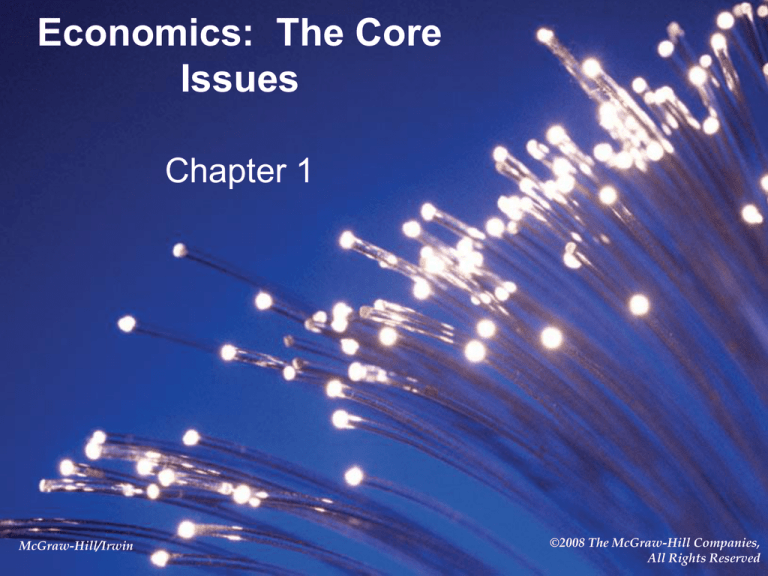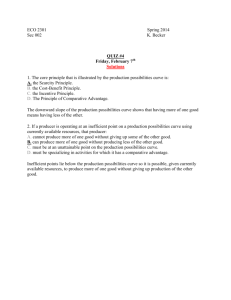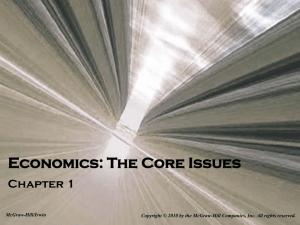
Economics: The Core
Issues
Chapter 1
McGraw-Hill/Irwin
©2008 The McGraw-Hill Companies,
All Rights Reserved
Economics
Economics is the study of how best
to allocate scarce resources among
competing uses.
2
Three core issues must be
resolved:
WHAT to produce with our limited
resources.
HOW to produce the goods and
services we select.
FOR WHOM goods and services are
produced; that is, who should get
them.
LO2
3
The Economy Is Us
The economy is an abstraction that
refers to the sum of all our individual
production and consumption
activities.
The economy is us — the
aggregation of all of our supply and
demand decisions.
4
Scarcity
Scarcity is the lack of enough
resources to satisfy all desired uses
of those resources.
LO1
5
Factors of Production
Factors of production are resource
inputs used to produce goods and
services.
6
Factors of Production
Land refers to all natural resources
such as crude oil, water, air, and
minerals.
Labor refers to the skills and abilities
to produce goods and services.
7
Factors of Production
Capital includes the final goods
produced for use in the production of
other goods, e.g., equipment,
structures.
Entrepreneurship is the assembling
of resources to produce new or
improved products and technologies.
8
Limits to Output
No matter how an economy is
organized there is a limit to how fast
it can grow.
The most evident limit is the amount
of resources available for producing
goods and services.
LO1
9
Limits to Output
Scarcity – the imbalance between our
desires and available resources –
forces us to make economic choices.
LO1
10
Opportunity Costs
Opportunity cost is the most
desired goods or services that are
forgone in order to obtain something
else.
It is what is given up in order to get
something else.
11
Production Possibilities
Production possibilities are the
alternative combinations of final
goods and services that could be
produced in a given period of time
with all available resources and
technology.
12
The Production Possibilities Curve
Each point on the production
possibilities curve depicts an
alternative mix of output.
13
The Production Possibilities Curve
Truck Production
Total Labor Truck Output x Labor per Truck =
Tank Production
Total Labor
Required
Labor Not Used Potential Output Increase in Tank
for Trucks
of Tanks per Day
Output
A 10
5
2
10
0
0
B 10
4
2
8
2
2.0
>
2.0
C 10
3
2
6
4
3.0
>
1.0
D 10
2
2
4
6
3.8
>
0.8
E 10
1
2
2
8
4.5
>
0.7
F 10
0
2
0
10
5.0
>
0.5
14
The Production Possibilities Curve
OUTPUT OF TRUCKS
5
A
B
4
C
3
D
2
E
1
0
1
2
3
4
5
F
OUTPUT OF TANKS
15
Production Possibilities Illustrates Two
Essential Principles
Scarce resources – there’s a limit to
the amount we can produce in a
given time period with available
resources and technology.
LO1
16
Production Possibilities Illustrates Two
Essential Principles
Opportunity costs – we can obtain
additional quantities of any desired
good only by reducing the potential
production of another good.
LO1
17
Law of Increasing Opportunity Costs
Resources do not transfer perfectly
from the production of one good to
another.
Increasing quantities of any good can
be obtained only by sacrificing everincreasing quantities of other goods.
18
Law of Increasing Opportunity Costs
The shape of the curve illustrates
increasing opportunity costs.
Resources used to produce trucks
aren’t ideally suited for producing
tanks.
19
Law of Increasing Opportunity Costs
OUTPUT OF TRUCKS
5
A
Step 1: give up one truck
B
4
3
2
Step 2: get two tanks
Step 3: give up another truck
C
Step 4: get one more tank
D
E
1
0
1
2
3
4
5
F
OUTPUT OF TANKS
20
The Cost of North Korea’s Military
North Korea’s inability to feed itself is
due in part to its large army.
Resources used for the military aren’t
available for producing food.
21
The Cost of North Korea’s Military
FOOD OUTPUT
A
G
P
Reduced food
output
C
O
N
Military buildup
H
MILITARY OUTPUT
D
B
22
The Military Share of Output
23
Efficiency
Efficiency means getting the
maximum output of a good from the
resources used in production.
Every point on a production
possibilities curves is efficient.
24
Inefficiency
A production possibilities curves
shows potential output, not
necessarily actual output.
If we are inefficient, actual output will
be less than the potential output.
25
Inefficiency
Countries may end up inside their
production possibilities curve if
resources are inefficiently combined.
Such inefficiencies plagued centrally
planned economies.
26
Unemployment
Countries may end up inside their
production possibilities curve if all
available resources are not used.
27
Unemployment
OUTPUT OF TRUCKS
5
A
4
B
3
Y
2
C
Unemployment
1
0
1
2
3
OUTPUT OF TANKS
4
5
28
Economic Growth
A point outside the production
possibilities curve suggests that we
could get more goods than we are
capable of producing!
Economic growth is an increase in
output (real GDP) – an expansion of
production possibilities.
29
Economic Growth
OUTPUT OF TRUCKS
5
A
X
Currently not attainable
B
4
C
3
2
1
0
1
2
3
OUTPUT OF TANKS
4
5
30
Economic Growth
Production possibilities increase with
more resources or better technology.
The production possibilities curve
shifts outward.
31
OUTPUT OF TRUCKS
Economic Growth
0
PP2
PP1
OUTPUT OF TANKS
32
Basic Decisions
Production possibilities define the
output choices confronting a nation:
WHAT to produce
HOW to produce
FOR WHOM to produce
LO2
33
WHAT
There are millions of points along a
production possibilities curve, and
each one represents a specific mix of
output.
We can choose only one of these
points at any time.
LO2
34
HOW
There are lots of different ways of
producing goods and services.
Someone has to make a decision
about which production methods to
use.
LO2
35
FOR WHOM
Who is going to get the output
produced?
LO2
36
The Mechanism of Choice
An economy is largely defined by
how it answers the WHAT, HOW and
FOR WHOM questions.
LO3
37
The Invisible Hand of a Market
Economy
The market mechanism is the use
of market prices and sales to signal
desired outputs (or resource
allocations).
The market decides the mix of output
in an economy.
LO3
38
The Invisible Hand of a Market
Economy
Laissez faire is the doctrine of leave
it alone — of nonintervention by
government in the market
mechanism.
LO3
39
Government Intervention and
Command Economies
Karl Marx argued that the
government not only had to intervene
but had to own all the means of
production.
Markets permit capitalists to enrich
themselves while the proletariat toil
long hours for subsistence wages.
LO3
40
Government Intervention and
Command Economies
John Maynard Keynes offered a less
drastic solution.
In Keynes’ view, government should
play an active but not an all-inclusive
role in managing the economy.
LO3
41
Continuing Debates
The core of most debates is some
variation of the WHAT, HOW, or FOR
WHOM questions.
Conservatives favor Adam Smith’s
laissez-faire approach.
Liberals tend to think government
intervention is likely to improve the
answers.
LO3
42
Continuing Debates
Countries answer the basic
economics questions differently and
their answers change over time.
LO3
43
A Mixed Economy
A mixed economy is one that uses
both market signals and government
directives to allocate goods and
resources.
Most economies use a combination
of market signals and government
directives to select economic
outcomes.
LO3
44
Market Failure
We may never find an absolute truth,
because the inner workings of the
economy change over time.
45
Government Failure
Government intervention may move
us closer to our economic goals or it
may fail.
A government failure is government
intervention that fails to improve
economic outcomes.
46
Seeking Balance
The challenge for society is to
minimize failures by selecting the
appropriate balance of market signals
and government directives.
47
What Economics Is All About
The basic purpose of studying
economics is understanding how
economies function.
How an economy is organized, how it
behaves, and how successfully it
achieves it basic objectives.
48
End Versus Means
Economists don’t formulate an
economy’s objectives.
They focus on the means available
for achieving given goals.
49
Macro Versus Micro
Macroeconomics is the study of
aggregate economic behavior, of the
economy as a whole.
Microeconomics is the study of
individual behavior in the economy, of
the components of the larger
economy.
50
Theory Versus Reality
The economy is much too vast and
complex to describe and explain in
one course (or one lifetime).
Economists use theories, or models,
of economic behavior to evaluate and
design economic policy.
51
Theory Versus Reality
In these theories, we typically ignore
the possibility that many things can
change at one time.
Ceteris paribus is the assumption
that nothing else is changing.
52
Politics
Political forces are a necessary
ingredient in economic policy
decisions.
Inevitably, political choices must be
made.
53
Imperfect Knowledge
We may never find an absolute truth,
because the inner workings of the
economy change over time.
54
Economics: the Core
Issues
End of Chapter 1
McGraw-Hill/Irwin
©2008 The McGraw-Hill Companies,
All Rights Reserved






